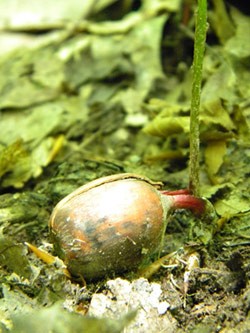Last night a friend from the next town over asked me whether I’d noticed an abundance of oak seedlings this fall. “Noticed?” Hell, I’ve been going nuts trying to figure out how oak seedlings could suddenly be popping up in droves where they never had been before. And so I was relieved to learn that I’m not the only puzzled bushwhacker around.
I saw the first oak seedling on our land four years ago, having seen zero in the previous 18 years of our ownership. Last year I noticed another one, and this year I’ve seen about 50 here and many more in the neighborhood. Their red leaves, two or four deep, are still hanging on and they’ve stood out, maybe more than usual in the warm, more or less snowless November we had. Being southern trees “they haven’t yet perfected the deciduous habit,” a phrase I read way back that sticks in my mind – unlike the name of its author.
Our neighborhood is not entirely oakless, but it’s close. Two high, rocky sidehills a couple of miles to the west of us each have a small patch of mature red oaks; their broad, brown-leaved crowns are visible from a long distance.
In the fall, blue jays eat and cache acorns and they are known to carry them in an expandable esophagus for 2.5 miles. The energy obtained from an acorn snack is used to transport the next nut – so both tree and bird win. Interestingly, jays can’t live on acorns alone as the high tannin content interferes with protein digestion. An acorn diet supplemented with acorn weevils, on the other hand, will sustain a jay and it’s been suggested that the weevils, usually considered to be bad for oaks, may instead benefit these trees because they make the acorns more palatable to jays, and not all acorns are infested. Jays are kind enough to bury the seeds, as well as to disperse them widely.
Red squirrels and many other animals are fond of acorns but none of them carry them any distance from the parent tree. Still, if it’s blue jays who are responsible for peppering the woods around here with little oaks, why did they wait until 2010? Someone’s going to say “global warming,” and, yes, I’m a believer, but, in the case of oaks, I’m a skeptic. Until someone has a better explanation, I’m sticking with the acorn fairy.



Discussion *